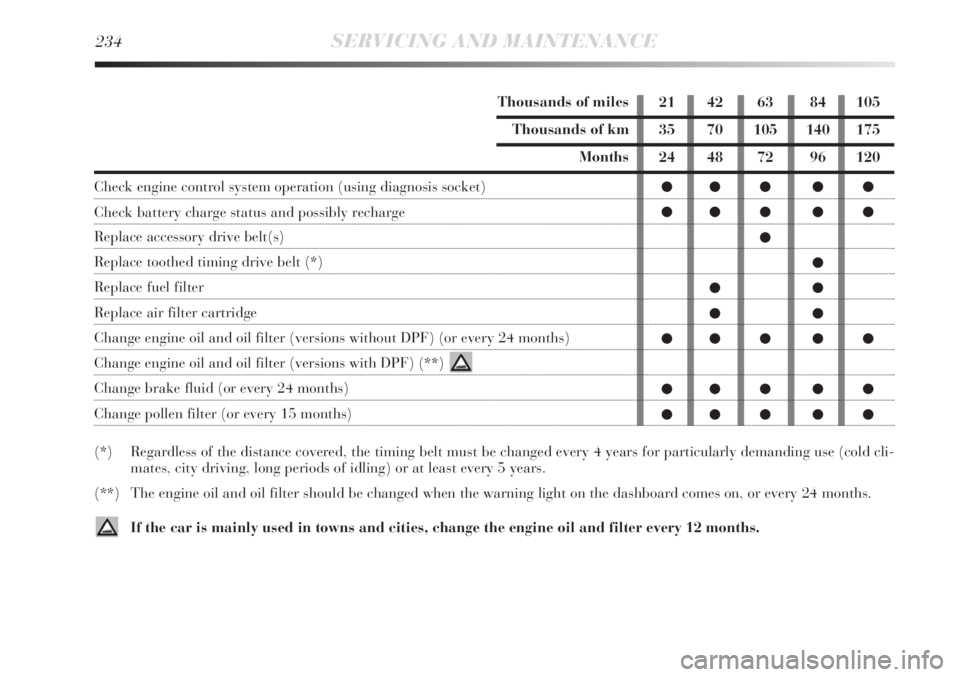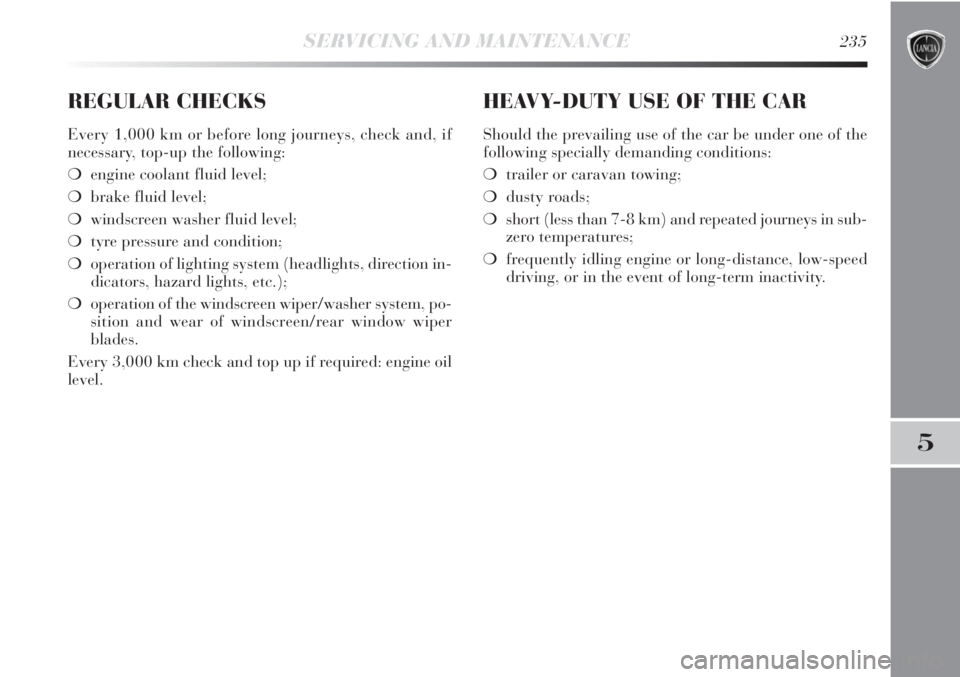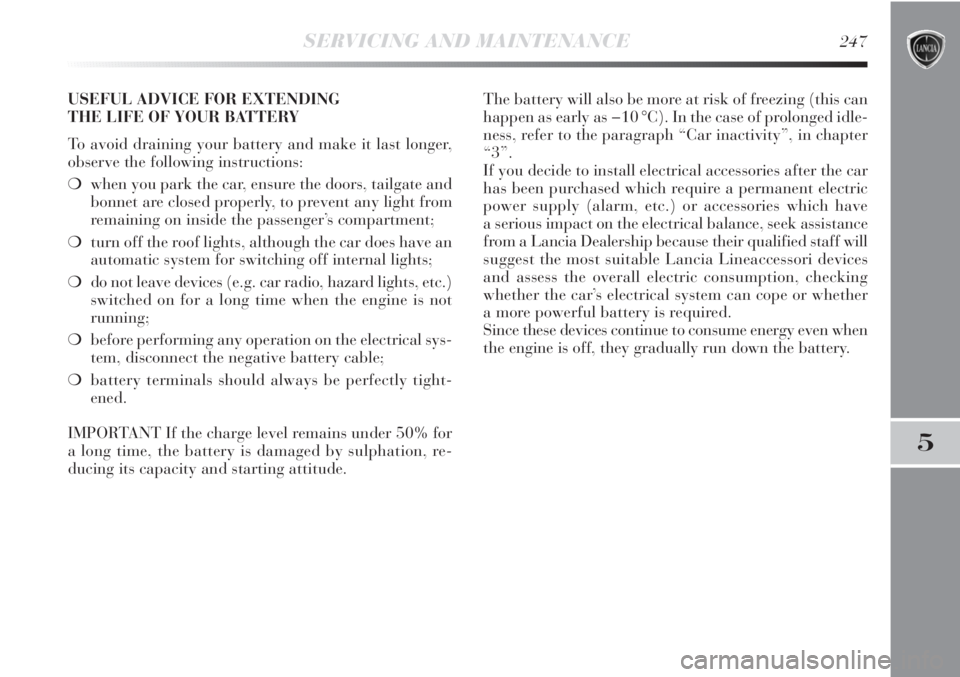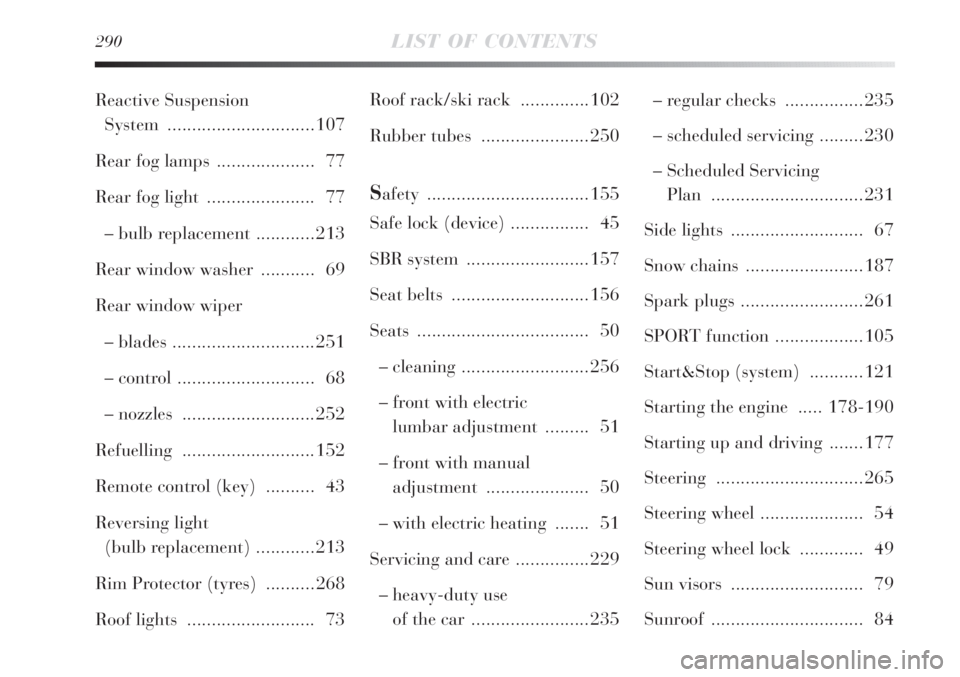check engine light Lancia Delta 2013 Owner handbook (in English)
[x] Cancel search | Manufacturer: LANCIA, Model Year: 2013, Model line: Delta, Model: Lancia Delta 2013Pages: 295, PDF Size: 8.29 MB
Page 233 of 295

18 36 54 72 90 108
30 60 90 120 150 180
24 48 72 96 120 144
●●● ●●●
●●● ●●●
●●● ●●●
●●● ●●●
●●● ●●●
●●● ●●●
●●● ●●●
●●● ●●●
●●● ●●●
●●● ●●●
●●
●●
SERVICING AND MAINTENANCE231
5
SCHEDULED SERVICING PLAN
Petrol versions
Thousands of miles
Thousands of km
Months
Check tyre condition/wear and adjust pressure if required
Check operation of lighting system (headlights, direction indicators,
hazard warning lights, luggage compartment, passenger compartment,
instrument panel warning lights, etc.)
Check windscreen wiper/washer operation
Check the position/wear of the windscreen/rear window wiper blades
Check condition and wear of front disc brake pads and operation
of pad wear indicator
Check rear disc brake pad condition and wear
Condition visual check: bodywork exterior, underbody protection,
pipes and hoses (exhaust – fuel supply system – braking system),
rubber elements (boots – sleeves – bushes – etc...)
Check cleanliness of bonnet and boot locks,
as well as cleanliness and lubrication of linkages
Check and top up, if required, fluid levels (engine coolant, brake/hydraulic
clutch fluid, windscreen washer fluid, battery fluid, etc)
Check handbrake lever travel and adjust if necessary
Visually inspect the condition of accessory drive belt(s)
Visually inspect the conditions of toothed timing belt
Page 235 of 295

SERVICING AND MAINTENANCE233
5
21 42 63 84 105
35 70 105 140 175
24 48 72 96 120
●● ● ● ●
●● ● ● ●
●● ● ● ●
●● ● ● ●
●● ● ● ●
●● ● ● ●
●● ● ● ●
●● ● ● ●
●● ● ● ●
●● ● ● ●
●●
●● ● ● ●
Diesel versions
Thousands of miles
Thousands of km
Months
Check tyre condition/wear and adjust pressure if required
Check operation of lighting system
(headlights, direction indicators, hazard warning lights, luggage compartment,
passenger compartment, instrument panel warning lights, etc.)
Check windscreen wiper/washer operation
Check the position/wear of the windscreen/rear window wiper blades
Check condition and wear of front disc brake pads and operation
of pad wear indicator
Check rear disc brake pad liner condition and wear
Condition visual check: bodywork exterior, underbody protection,
pipes and hoses (exhaust – fuel supply system – braking system),
rubber elements (boots – sleeves – bushes – etc...)
Check cleanliness of bonnet and boot locks,
as well as cleanliness and lubrication of linkages
Check and top up, if required, fluid levels
(engine coolant, brake/hydraulic clutch fluid, windscreen washer fluid, battery fluid, etc)
Check handbrake lever travel and adjust if necessary
Check tension and conditions of various accessory drive belts
Check exhaust fumes/emissions
Page 236 of 295

234SERVICING AND MAINTENANCE
Thousands of miles
Thousands of km
Months
Check engine control system operation (using diagnosis socket)
Check battery charge status and possibly recharge
Replace accessory drive belt(s)
Replace toothed timing drive belt (*)
Replace fuel filter
Replace air filter cartridge
Change engine oil and oil filter (versions without DPF) (or every 24 months)
Change engine oil and oil filter (versions with DPF) (**)
Change brake fluid (or every 24 months)
Change pollen filter (or every 15 months)
(*) Regardless of the distance covered, the timing belt must be changed every 4 years for particularly demanding use (cold cli-
mates, city driving, long periods of idling) or at least every 5 years.
(**) The engine oil and oil filter should be changed when the warning light on the dashboard comes on, or every 24 months.
If the car is mainly used in towns and cities, change the engine oil and filter every 12 months.
21 42 63 84 105
35 70 105 140 175
24 48 72 96 120
●● ● ● ●
●● ● ● ●
●
●
●●
●●
●● ● ● ●
●● ● ● ●
●● ● ● ●
Page 237 of 295

SERVICING AND MAINTENANCE235
5
REGULAR CHECKS
Every 1,000 km or before long journeys, check and, if
necessary, top-up the following:
❍engine coolant fluid level;
❍brake fluid level;
❍windscreen washer fluid level;
❍tyre pressure and condition;
❍operation of lighting system (headlights, direction in-
dicators, hazard lights, etc.);
❍operation of the windscreen wiper/washer system, po-
sition and wear of windscreen/rear window wiper
blades.
Every 3,000 km check and top up if required: engine oil
level.
HEAVY-DUTY USE OF THE CAR
Should the prevailing use of the car be under one of the
following specially demanding conditions:
❍trailer or caravan towing;
❍dusty roads;
❍short (less than 7-8 km) and repeated journeys in sub-
zero temperatures;
❍frequently idling engine or long-distance, low-speed
driving, or in the event of long-term inactivity.
Page 249 of 295

SERVICING AND MAINTENANCE247
5
USEFUL ADVICE FOR EXTENDING
THE LIFE OF YOUR BATTERY
To avoid draining your battery and make it last longer,
observe the following instructions:
❍when you park the car, ensure the doors, tailgate and
bonnet are closed properly, to prevent any light from
remaining on inside the passenger’s compartment;
❍turn off the roof lights, although the car does have an
automatic system for switching off internal lights;
❍do not leave devices (e.g. car radio, hazard lights, etc.)
switched on for a long time when the engine is not
running;
❍before performing any operation on the electrical sys-
tem, disconnect the negative battery cable;
❍battery terminals should always be perfectly tight-
ened.
IMPORTANT If the charge level remains under 50% for
a long time, the battery is damaged by sulphation, re-
ducing its capacity and starting attitude.The battery will also be more at risk of freezing (this can
happen as early as −10 °C). In the case of prolonged idle-
ness, refer to the paragraph “Car inactivity”, in chapter
“3”.
If you decide to install electrical accessories after the car
has been purchased which require a permanent electric
power supply (alarm, etc.) or accessories which have
a serious impact on the electrical balance, seek assistance
from a Lancia Dealership because their qualified staff will
suggest the most suitable Lancia Lineaccessori devices
and assess the overall electric consumption, checking
whether the car’s electrical system can cope or whether
a more powerful battery is required.
Since these devices continue to consume energy even when
the engine is off, they gradually run down the battery.
Page 292 of 295

290LIST OF CONTENTS
Roof rack/ski rack ..............102
Rubber tubes ......................250
Safety .................................155
Safe lock (device) ................ 45
SBR system .........................157
Seat belts ............................156
Seats ................................... 50
– cleaning ..........................256
– front with electric
lumbar adjustment ......... 51
– front with manual
adjustment ..................... 50
– with electric heating ....... 51
Servicing and care ...............229
– heavy-duty use
of the car ........................235– regular checks ................235
– scheduled servicing .........230
– Scheduled Servicing
Plan ...............................231
Side lights ........................... 67
Snow chains ........................187
Spark plugs .........................261
SPORT function ..................105
Start&Stop (system) ...........121
Starting the engine ..... 178-190
Starting up and driving .......177
Steering ..............................265
Steering wheel ..................... 54
Steering wheel lock ............. 49
Sun visors ........................... 79
Sunroof ............................... 84 Reactive Suspension
System ..............................107
Rear fog lamps .................... 77
Rear fog light ...................... 77
– bulb replacement ............213
Rear window washer ........... 69
Rear window wiper
– blades .............................251
– control ............................ 68
– nozzles ...........................252
Refuelling ...........................152
Remote control (key) .......... 43
Reversing light
(bulb replacement) ............213
Rim Protector (tyres) ..........268
Roof lights .......................... 73